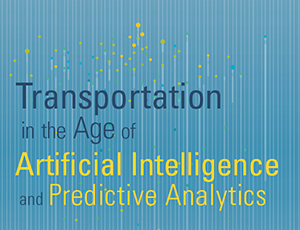A Conversation on Artificial Intelligence in Transportation with Kyle Vogt and U.S. DOT Under Secretary Derek Kan
Kyle Vogt, founder and CEO of Cruise Automation, Inc., and Derek Kan, U.S. DOT Under Secretary of Transportation for Policy, spoke as part of the U.S. DOT Volpe Center’s Transportation in the Age of Artificial Intelligence and Predictive Analytics speaker series on October 4, 2018.
The following has been edited for clarity and length. Please see the video highlight and full video for more of their conversation.
Under Secretary Kan: Kyle started his career just down the street at MIT (Massachusetts Institute of Technology). MIT does a lot of brilliant things, probably most notably tech development. Given all the things you’ve done in your career, walk us through some of the big challenges in autonomous vehicle (AV) technology development.
Kyle Vogt: I’ll be the first to say this is a really, really hard problem. This is one of the first really great applied AI (artificial intelligence) problems. At this point it’s become clear that building a prototype autonomous vehicle is something that 5 or 10 talented engineers can do in a few months.
What is becoming apparent now is that the difference between a prototype that can drive around the block once and not hit something, and a commercial product that people can entrust their safety to, is enormous. It’s several orders of magnitude more complex, it takes more time to design, develop, to validate and to collect data on, and so there are immense challenges.
Under Secretary Kan: As everybody here knows, transportation is one of the keys to a vibrant economy. The sector itself is incredible. So how do AVs fit into the broader transportation system?
Vogt: First off, transportation is huge: 3.2 trillion miles traveled in a year. If you look at what AVs could do to that, we can look at the rideshare industry as a proxy for what it might become. Rideshare companies today drive less than 1 percent of those 3.2 trillion miles traveled, so everything you think about rideshare, that’s just the tip of the iceberg in terms of having an impact on transportation.
AVs have the potential to lower the cost of transportation like in rideshare, to the point where a lot of people are going to flip from owning a car and all the burden that comes with that to using a shared autonomous vehicle on a rideshare network. It’s going to make sense economically, it’s going to be safer, more convenient, it’s going to give you that time back that you spend on your commute.
Under Secretary Kan: What areas of research and development should be done either in the application, development, or testing and deployment of AV technology?
Vogt: The things that are underexploited today are the things that come a little further into the future. There’s a lot of focus right now on sensor processing and the first versions of self-driving car systems. What there isn’t as much of is thinking about vehicles at a fleet scale. Not just building the first self-driving car, but what happens when you have hundreds or thousands of these in a city and they’re all sharing information? Can they look around corners? How can they coordinate to do things like reducing congestion, or even acting as infrastructure for one another?
Under Secretary Kan: You mentioned that AVs are perhaps the best application of AI. Help us unpack that a little bit. You talked about sensing, but why is today unique and what is the arc of AI today that makes this time special?
Vogt: Engineers love to work on AI problems because there are some promising results and there is a lot of innovation in the field right now. What’s happening with AVs now is because there is a huge market opportunity and because there is a huge social impact on improving safety. In our case we’re using electric vehicles so it’s a cleaner form of transportation. All of those things are motivating more people to enter the space and work on these problems. What I meant was this is one of the most impactful applied AI problems you can do today.
People coming out of graduate programs and getting degrees now have a place to go where they can take that academic curiosity and fascination and apply it to a problem that has perhaps one of the largest impacts of any engineering work being done today. That’s a powerful combination. This only happens maybe once every ten years or several decades where you have this convergence of high social impact, deeply challenging technology problem, and big market opportunity. When those three things come together it creates something really special. I see self-driving cars today as the Apollo program of this generation.

